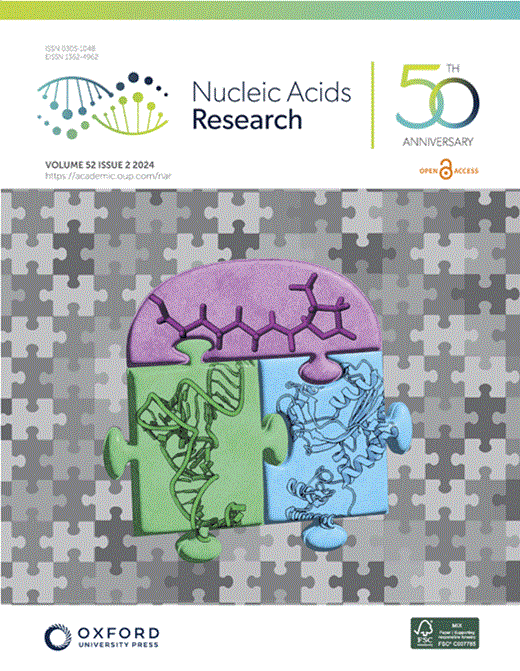Highly conserved ribosome biogenesis pathways between human and yeast revealed by the MDN1-NLE1 interaction and NLE1 containing pre-60S subunits
IF 16.6
2区 生物学
Q1 BIOCHEMISTRY & MOLECULAR BIOLOGY
引用次数: 0
Abstract
The assembly of ribosomal subunits, primarily occurring in the nucleolar and nuclear compartments, is a highly complex process crucial for cellular function. This study reveals the conservation of ribosome biogenesis between yeast and humans, illustrated by the structural similarities of ribosomal subunit intermediates. By using X-ray crystallography and cryo-EM, the interaction between the human AAA+ ATPase MDN1 and the 60S assembly factor NLE1 is compared with the yeast homologs Rea1 and Rsa4. The MDN1-MIDAS and NLE1-Ubl complex structure at 2.3 Å resolution mirrors the highly conserved interaction patterns observed in yeast. Moreover, human pre-60S intermediates bound to the dominant negative NLE1-E85A mutant revealed at 2.8 Å resolution an architecture that largely matched the equivalent yeast structures. Conformation of rRNA, assembly factors and their interaction networks are highly conserved. Additionally, novel human pre-60S intermediates with a non-rotated 5S RNP and processed ITS2/foot structure but incomplete intersubunit surface were identified to be similar to counterparts observed in yeast. These findings confirm that the MDN1-NLE1-driven transition phase of the 60S assembly is essentially identical, supporting the idea that ribosome biogenesis is a highly conserved process across eukaryotic cells, employing an evolutionary preservation of ribosomal assembly mechanisms.MDN1-NLE1相互作用和含有前60S亚基的NLE1揭示了人类和酵母之间高度保守的核糖体生物发生途径
本文章由计算机程序翻译,如有差异,请以英文原文为准。
求助全文
约1分钟内获得全文
求助全文
来源期刊

Nucleic Acids Research
生物-生化与分子生物学
CiteScore
27.10
自引率
4.70%
发文量
1057
审稿时长
2 months
期刊介绍:
Nucleic Acids Research (NAR) is a scientific journal that publishes research on various aspects of nucleic acids and proteins involved in nucleic acid metabolism and interactions. It covers areas such as chemistry and synthetic biology, computational biology, gene regulation, chromatin and epigenetics, genome integrity, repair and replication, genomics, molecular biology, nucleic acid enzymes, RNA, and structural biology. The journal also includes a Survey and Summary section for brief reviews. Additionally, each year, the first issue is dedicated to biological databases, and an issue in July focuses on web-based software resources for the biological community. Nucleic Acids Research is indexed by several services including Abstracts on Hygiene and Communicable Diseases, Animal Breeding Abstracts, Agricultural Engineering Abstracts, Agbiotech News and Information, BIOSIS Previews, CAB Abstracts, and EMBASE.
 求助内容:
求助内容: 应助结果提醒方式:
应助结果提醒方式:


